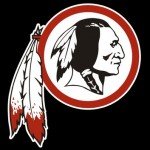 I am a proud alum of Lyme-Old Lyme High School, class of 2010. I could not have asked for a better education or community. One of the most important experiences I had as a student there was my involvement in athletics. I enjoyed every moment of cross country that did not involve running, and during basketball games, I ensured that the team’s bench remained warm at all times. I also supported my friends in their athletic pursuits, especially those dedicated enough to travel to another school to play football for the Valley Regional Warriors. Having heard about their growing success, I’ve begun to follow along once more and I’m proud to see that some of the team’s best players are from LOLHS, some of whom I know from my time as a summer camp counselor in town. However, I was saddened to see that the image used for the mascot is an antiquated, stereotypical depiction of Native Americans.
I am a proud alum of Lyme-Old Lyme High School, class of 2010. I could not have asked for a better education or community. One of the most important experiences I had as a student there was my involvement in athletics. I enjoyed every moment of cross country that did not involve running, and during basketball games, I ensured that the team’s bench remained warm at all times. I also supported my friends in their athletic pursuits, especially those dedicated enough to travel to another school to play football for the Valley Regional Warriors. Having heard about their growing success, I’ve begun to follow along once more and I’m proud to see that some of the team’s best players are from LOLHS, some of whom I know from my time as a summer camp counselor in town. However, I was saddened to see that the image used for the mascot is an antiquated, stereotypical depiction of Native Americans.
The image used to represent the “warriors” is a red face with black hair and two loosely hanging feathers. It is, in my opinion, a highly problematic image. The image would be problematic anywhere, but it is particularly troubling given the region’s history of violence against native peoples. The Pequot War, the war that ensured colonial hegemony in Connecticut, culminated with the Mystic Massacre of 1637, during which colonists and their native allies attacked a Pequot village and shot or burned to death over 400 hundred men, women, and children. The attackers targeted the village after bypassing a stronghold of warriors, knowing that non-combatants would put up less of a fight. To misappropriate the imagery of that time period is a deeply uninformed way of grappling with our violent history.
This imagery also promotes a racialized view of American life. The idea that there is a race of “red” people is an idea that Euro-Americans constructed in the 18th and 19th centuries to justify campaigns of conquest and displacement. Far from being an ideology of the past, this racism is still very much alive and dangerous. Few people know that police kill Native American men at about the same rate as African American men. It has been encouraging to see the removal of imagery that glorifies the Confederacy and chattel slavery, and we must now remove symbols that trivialize the centuries-old abuses of native peoples. Only then can we begin to combat the caustic racism that continues to permeate our society.
Finally, using Native Americans as mascots promotes the myth of the “vanishing Indian.” This myth, which dates back to the early-19th century, contends that Native Americans died out in the course of American history, unable to adapt to new contexts or hold their lands. The myth could not be more wrong. Native peoples, who represent countless languages, cosmologies, and identities, have displayed remarkable resilience and have been intertwined in American life since the early-colonial period. Native peoples have shaped American politics, contributed to the American ethos, and served in our wars in greater proportion than any other population. And they have fought tenaciously to preserve their lands and cultures. While they lost a great deal under the onslaught of imperialism, and now grapple with the resulting poverty and trauma, they are proud of what they have maintained. I’ve travelled to numerous reservations—I recently returned from a month-long trip to the beautiful Standing Rock Reservation in North Dakota—and the people there work tirelessly to elevate their communities without losing sight of their heritage. They continue to fight, every day, to revitalize their languages and resist new forms of encroachment, such as the Keystone XL Pipeline. They’re not a novelty or a relic of the past. They are students and teachers and parents and artists, and they cannot be encapsulated by a picture of a red face and feathers.
I’m being oversensitive, you might say. Perhaps. The mascot debate is by no means our most important. But it’s a good place to start. So can we change the image used by Valley Regional’s football team? The important things—the lines on the field, the minutes in a half, the positive impact of playing on a team—will remain unchanged. This problematic image will be the only thing to go, and when it does, our boys will have even more to be proud of.
Editor’s Note: Michael McLean graduated from Lyme-Old Lyme High School in 2010. He went on to obtain an undergraduate degree from Trinity College in 2014 and is currently studying for his PhD in American History at Boston College. He is a contributor to the online history magazine, “We’re History” at http://werehistory.org.